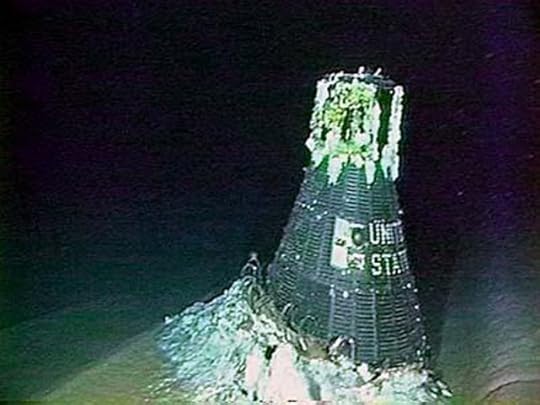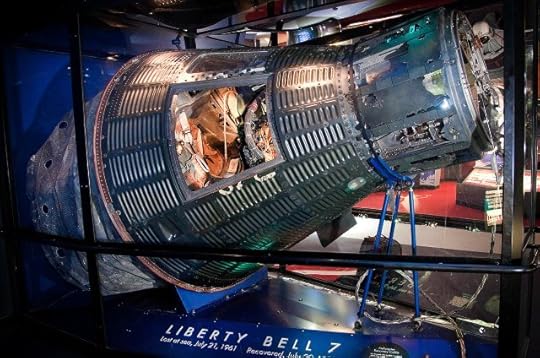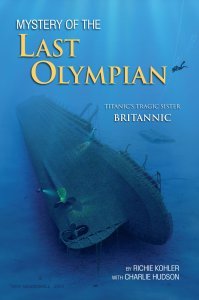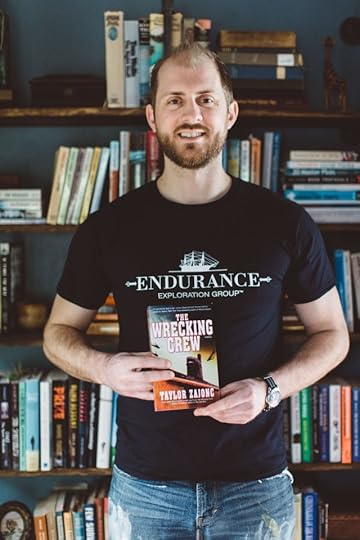Taylor Zajonc's Blog, page 6
March 29, 2016
Japanese Whaling: The World’s Worst Research Expedition
It’s almost impossible to provide an original editorial perspective on the modern-day Japanese whale hunt. The practice is wholly deplorable and universally condemned. The rationale is so patently absurd that it squeezes out any opportunity to provide thoughtful insight, context or nuance. Whaling is simply terrible and depressing, the kind of thing that makes us ask ourselves why we, as a planet, still can’t get the easy questions right.
If you want facts and figures, Vox.com has written a brilliant summary per usual. Here are a few highlights–or rather, lowlights.
Japan recently returned from whaling the waters of the southern pole with 333 minke whales. Of those whales, 157 were pregnant. Though not endangered, their numbers are in decline. The hunt was conducted in direct violation of orders from the International Court of Justice.
If one were to take Japanese claims of engaging in oceanic research at face value, the situation is not just tragic, but farcical. Despite funding whaling “research” at a cost of $10,000,000 per year, only two peer-reviewed papers have been released since 2005; both of dubious value.
In my effort to contribute something to the conversation other than my deep sadness, I hope you’ll take a moment to read the essay below. It’s excerpted from my unpublished novel THE ACTIVIST and illustrates my strong feelings on the subject; specifically that whaling is a intentional distraction, a firebreak preventing larger action against the current state of unsustainable fishing practices.
The Japanese claim the heritage of their whaling practices dates back to the twelfth century. That’s technically true but highly misleading. Whaling before the 1800’s was a small scale endeavor, tiny boats in shallow water driving whales towards shore, then spearing and butchering them near coastal villages.
Japan came into European-style whaling—long-range sail or steam-powered ships armed with modern gunpowder or compressed-air harpoons—in the late 1800’s, after the industry had already peaked and collapsed in most other countries. As part of their rapid industrialization in the late 19th and early 20th centuries, Japan copied cutting-edge Scandinavian hunting practices and Western corporate structuring, quickly rising to become a top whaling nation alongside Norway and Iceland. This meant fast, diesel-fueled engines on ships equipped with modern radar and exploding harpoons.
The modern environmentalist movement came into its own in the 1970’s and 1980’s, just in time to see whales teetering on the brink of extinction. Awareness campaigns and international pressure shifted popular opinion and most of the world abandoned the whaling industry.
And yet Japan did not cease the hunt. In a blatant affront to a bevy of anti-whaling laws and treaties, Japan issued itself lethal “research permits” to stalk and kill whales, a thin veil of legitimacy whitewashing an ugly reality. To gain the international support necessary for these phony permits, Japan did what any nation engaged in dirty practices does—funded foreign economic development projects, paid favors to officials and occasionally engaged in outright bribery.
Though Japan has only one whaling fleet (a fleet consisting of a single cannery “factory” ship and four smaller harpoon boats) her swath of destruction is incredible. Every year, she sets out with a quota to hunt fifty fin whales, fifty humpback whales and a staggering thousand minke whales.
The very idea they are somehow conducting research is offensive. Most of the whale meat ends up in Tsukiji fish market or on the government-subsidized plates of Japanese schoolchildren. Nobody knows what these yearly culling do to the psyche of these intelligent, gentle beings. Take elephant herds, perhaps the nearest land equivalent of a mammalian whale. Elephant herd cullings have been found to devastate generations. Surviving elephants manifest bereavement, post-traumatic stress behavior and violent hostility towards both people and each other. Maybe that’s why in the mid 1800’s sailors began reporting stories of grief-mad bull whales charging and capsizing smaller ships, often killing themselves in the process.
I have a theory on why Japan still whales. They don’t do it despite how terrible the practice remains; they do it because it’s so horrifying. When the world’s attention is focused on the suffering of these beloved mammals, few pay attention to how Japan’s fishing fleets strip the world’s oceans bare. (They are, of course, far from the only nation guilty of this.) It’s like a crew of gangsters shooting up a liquor store as a distraction for their real objective—robbing a bank. We’re all being robbed and most of us don’t even know it. If we don’t make hard changes as a species, soon we’ll have nothing left.
Excerpted from THE ACTIVIST by Taylor Zajonc: In this retelling of Moby Dick, an idealistic environmental activist signs on for a dangerous voyage to Antarctica with Captain Ernie King, an obsessive and enigmatic figure who will stop at nothing to end whaling in the Southern Ocean.
March 14, 2016
Thank You Auntie’s Bookstore!
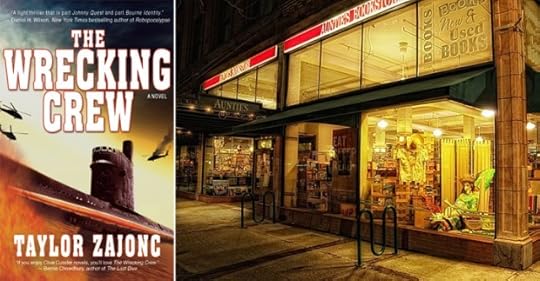 A huge thank-you to Heather, Holly, Candy, Chris, Shannon of Auntie’s Bookstore and everyone who came to the March 11 launch event for my debut novel, The Wrecking Crew! I grew up wandering Auntie’s endless shelves, and came home with many a favorite book. The day I returned to read my own novel is a moment I will treasure for a long, long time to come.
A huge thank-you to Heather, Holly, Candy, Chris, Shannon of Auntie’s Bookstore and everyone who came to the March 11 launch event for my debut novel, The Wrecking Crew! I grew up wandering Auntie’s endless shelves, and came home with many a favorite book. The day I returned to read my own novel is a moment I will treasure for a long, long time to come.
Interview with an Explorer: Marine Archaeologist Neil Dobson
For the latest in my Interview with an Explorer series, it’s my pleasure to speak with Neil Dobson of Scotland, a marine archaeologist with more experience excavating deep-water shipwrecks than any other archaeologist in the world!
Neil has more than 40 years in the marine and offshore industry and comes from a long line of seafaring ancestors who can be traced back more than 250 years ago. His career spans being a Merchant Navy Deck Officer, a Watchstander/Stability Officer on various oil rigs, an offshore survival instructor/examiner and an HSE part III commercial diver, He graduated from St. Andrews University with a Master’s in Marine Archaeology and is one of a very small number of archaeologists worldwide who have successfully conducted archaeology in deep-water. Neil is also an International Marine Contractors Association (IMCA) remotely operated vehicle (ROV) pilot.
 Neil has worked on scores of shipwreck sites and supervised archaeological work on many high profile projects, including the SS Republic, Nuestra Señora de las Mercedes, HMS Victory, RMS Lusitania, SS Gairsoppa and the SS Central America projects along with many other projects in the Mediterranean Sea and the Atlantic Ocean.
Neil has worked on scores of shipwreck sites and supervised archaeological work on many high profile projects, including the SS Republic, Nuestra Señora de las Mercedes, HMS Victory, RMS Lusitania, SS Gairsoppa and the SS Central America projects along with many other projects in the Mediterranean Sea and the Atlantic Ocean.
A regular on the lecture and public speaking circuit, Neil has starred in global shows on Discovery, National Geographic, History Channel, PBS and BBC.
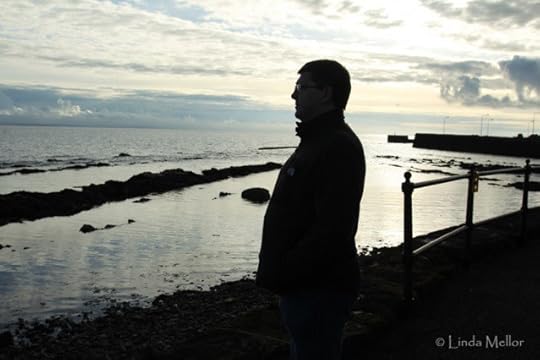 Tell us about your most recent project
Tell us about your most recent project
One exciting and interesting shipwreck I have recently worked on is the paddle-steamer SS Central America, known as the “Ship Of Gold”. This 85-meter (280-foot) east coast built paddle steamer was launched in 1852 and operated by the United States Mail Steamship Company. She sailed the route between Panama and New York as part of the San Francisco – New York run during the California Gold Rush. Carrying a large shipment of gold ingots and personal gold in the form of coins, nuggets and dust she was lost in a hurricane on 12 September 1857 off the coast of South Carolina.
In 1988 the Columbus America Discovery Group acting as agents for Recovery Limited Partnership located the SS Central America in 2,200m of water. Using ROV (Remotely Operated Vehicle) technology the wreck was worked between 1988 and 1991 but only a small part of the gold cargo was recovered. Due to legal battles no further excavation of the wreck was conducted.
All this changed in 2014 when Recovery Limited Partnership awarded Odyssey Marine Exploration the contract to archaeologically investigate and excavate the wreck site and recover the remaining gold. Six months were spent working on the site of which I spent 5 months.
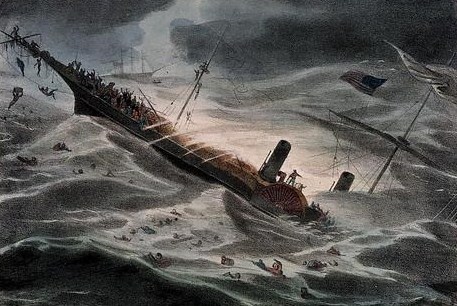 What inspired you to begin this project or expedition?
What inspired you to begin this project or expedition?
I am a commercial archaeologist specializing in deep-water wrecks. Having excavated a post US Civil War paddle-steamer, I could not say no when the opportunity to excavate a pre-US Civil War paddle-steamer presented itself. Also the client knew of my experience and knowledge of deep-water shipwreck investigations and excavations, I was the archaeologist for the job.
What did you learn from this experience?
Investigating and excavating the SS Central America was an opportunity for me to conduct the archaeology on a second paddle-steamer. This allowed me to make comparisons of the both paddle-steamers and explore the variations. Also, I gained further knowledge about gold in its natural and processed states. Most of all I got an insight of life during the California Gold Rush. I look forward to my next paddle-steamer who ever she is.
 What would be your advice to someone that wants to take on their own larger-than-life challenge?
What would be your advice to someone that wants to take on their own larger-than-life challenge?
My advice; if you have a passion, go for it, follow your dreams and never give up.
Who is your favorite explorer, adventurer or scientist?
I have many favourites; Sir John Murray, early 20th century pioneering Scottish oceanographer and marine biologist. In marine archaeology, the Fort Augustus Abbey monk Odo Blundell who using hard hat diving gear was a pioneer of crannog archaeology in the early 20th century. My adventurer would be Admiral Thomas Cochrane.
What’s next?
At the moment I am at home looking for new projects and challenges. There are many shipwrecks still to be discovered.
Thanks so much to Neil Dobson for sharing a window into his amazing work! Check out the incredible video below about his work.
March 5, 2016
Climate Change Disaster Tourism: New Cruise Route to Ply Arctic Northwest Passage
 In a move that can only be described as climate change disaster tourism of the first order, cruise line Crystal Cruises announced Tuesday that they intend to ply the Northwest Passage from Anchorage, Alaska to New York city with the 68,000 ton, 820-foot Crystal Serenity cruise ship. Fares start at $21,855 per person for double-occupancy rooms and are already reported as sold out and with a waiting list of 400. Penthouse suites cost more than $120,000 per occupant.
In a move that can only be described as climate change disaster tourism of the first order, cruise line Crystal Cruises announced Tuesday that they intend to ply the Northwest Passage from Anchorage, Alaska to New York city with the 68,000 ton, 820-foot Crystal Serenity cruise ship. Fares start at $21,855 per person for double-occupancy rooms and are already reported as sold out and with a waiting list of 400. Penthouse suites cost more than $120,000 per occupant.
 Stretching well into the Arctic Circle, the Northwest Passage is northern sea route between the the Pacific and Atlantic oceans. Sought for centuries as a potential trade route between Europe and the East, the route was first navigated in 1903-1906 by explorer Roald Amundsen.
Stretching well into the Arctic Circle, the Northwest Passage is northern sea route between the the Pacific and Atlantic oceans. Sought for centuries as a potential trade route between Europe and the East, the route was first navigated in 1903-1906 by explorer Roald Amundsen.
The Canadian Coast Guard will monitor the cruise ship daily during her voyage, though it is unclear what they would be able to do to assist in an large-scale emergency given the remote route. Canadian authorities have committed to enacting their “Environmental Response Program” if ‘pollution occurs’ in the ecologically sensitive region, though again the timeliness, scale and efficacy of such a program is again unclear.
The Crystal Serenity’s waste management procedures have not been made public at this time, nor how the ship will handle the 2 million galleons of human sewage and grey water their passengers are expected to produce over the course of the four-and-a-half week voyage. There’s much reason to be skeptical – in a 2013 cruise line “report card” issued by the Friends of the Earth, Crystal Cruises came in last out of a list of 16 major lines, earning an F in both sewage treatment and air pollution reduction. Further, there are no existing facilities on route designed to handle the influx of waste.
Climate change has only recently made the dangerous route navigable. In 2007, the European Space Agency recorded a record loss of ice in their satellite measurements, rendering the passage “fully navigable” for the first time. This pronouncement was followed by commercial shipping beginning 2008 and comes amidst increasing competition for newly-accessible hydrocarbon and mineral resources in the Arctic.
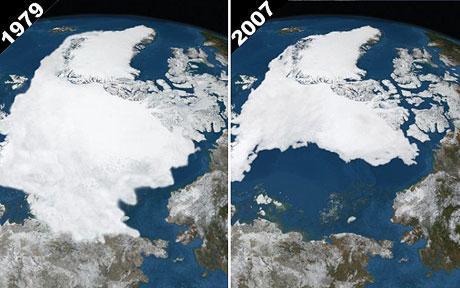 All early indications are that the sold-out cruise will be a financial success, barring any accidents or other misfortune at sea. Other major cruise lines are no doubt watching the voyage closely; and we may soon see a scramble of other companies as they take advantage of the increasingly ice-free waters. The Northwest Passage is now open for business.
All early indications are that the sold-out cruise will be a financial success, barring any accidents or other misfortune at sea. Other major cruise lines are no doubt watching the voyage closely; and we may soon see a scramble of other companies as they take advantage of the increasingly ice-free waters. The Northwest Passage is now open for business.
March 3, 2016
Thank You Broadway Books!
A huge thank-you to Portland’s own Broadway Books and everyone who came to the March 1 launch event for my debut novel, The Wrecking Crew! I had a wonderful time with friends old and new; and Broadway was nothing short of phenomenal to work with at every step in the process. Attaching a few of my favorite photos below – enjoy! (Thanks to Andrea Zajonc Photography for the fantastic images!)
March 1, 2016
The Long, Strange Journey of Liberty Bell 7
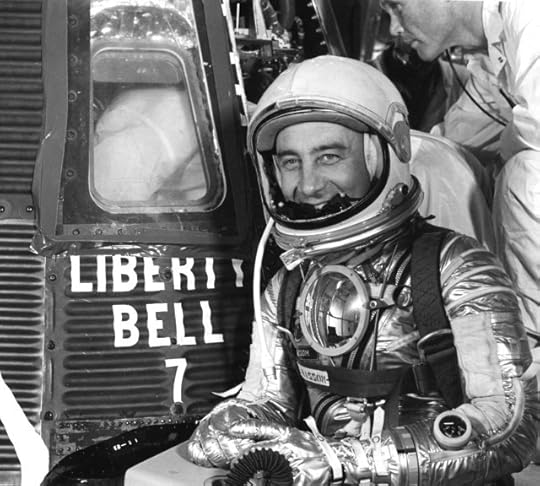 July 21, 1961 – NASA prepares for their second manned launch, a 15-minute suborbital shot designed to place astronaut Gus Grissom a hundred miles above the surface of the earth.
July 21, 1961 – NASA prepares for their second manned launch, a 15-minute suborbital shot designed to place astronaut Gus Grissom a hundred miles above the surface of the earth.
Everything went perfectly as space capsule “Liberty Bell 7”atop the Mercury-Redstone 4 rocket lifted off from Cape Canaveral, Florida and began her three hundred mile flight eastward over the Atlantic. Grissom initiated his reentry sequence at 120 miles altitude, sending the lone capsule plummeting back towards earth. Parachutes deployed at 21,000 feet, slowing the spacecraft in preparation for oceanic splashdown.
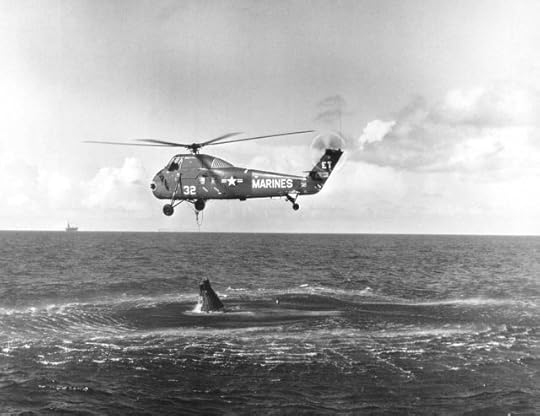 Liberty Bell 7 hit the water, heeling over in the swells. With recovery helicopters inbound, Grissom prepared to exit the capsule. Without warning, a “dull thud” sounded in the cabin as the hatch cover blew open and the spacecraft began taking on water. Things were beginning to go very, very wrong—if Grissom hadn’t already unbuckled his harness he might not have been able to escape as the craft began to sink. Abandoning the capsule, Grissom began to swim for his life.
Liberty Bell 7 hit the water, heeling over in the swells. With recovery helicopters inbound, Grissom prepared to exit the capsule. Without warning, a “dull thud” sounded in the cabin as the hatch cover blew open and the spacecraft began taking on water. Things were beginning to go very, very wrong—if Grissom hadn’t already unbuckled his harness he might not have been able to escape as the craft began to sink. Abandoning the capsule, Grissom began to swim for his life.
The incoming helicopter pilot fell back on his training, focusing on the capsule rather than the swimming astronaut. But the craft had already taken on too much water, almost pulling the helicopter down with it as it sank. A second chopper moved in to pick up Grissom, who himself was struggling and began to sink due to an unsecured intake valve in his space suit.
 Had Grissom panicked and blown the hatch without authorization? Independent inquiries did not believe so, despite the insistence of some within the engineering team. The administration sided with Grissom, keeping him in a command position during the future Gemini and Apollo projects. Liberty Bell 7 was deemed lost forever.
Had Grissom panicked and blown the hatch without authorization? Independent inquiries did not believe so, despite the insistence of some within the engineering team. The administration sided with Grissom, keeping him in a command position during the future Gemini and Apollo projects. Liberty Bell 7 was deemed lost forever.
But the story of the space capsule doesn’t end there—in 1999, Discovery Channel and Oceaneering International lead a mission to find and retrieve the lost Liberty Bell 7 capsule from a depth of nearly 15,000 feet. The spacecraft is now displayed in the Kansas Cosmosphere and Space Center.
See the harrowing rescue and the modern rediscovery of the capsule:
February 25, 2016
New Book by Famed Diver Richie Kohler – Mystery of the Last Olympian
Just picked up my SIGNED COPY of Richie Kohler and Charlie Hudson’s fantastic new book MYSTERY OF THE LAST OLYMPIAN! I can’t even tell you how excited I am to read this one, Kohler’s knowledge and experience in this realm are second to none.
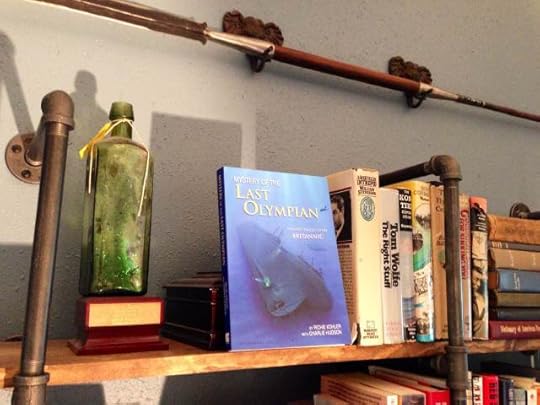 A new addition to my library!
A new addition to my library!The HMHS Britannic was the third and final vessel of the White Star Line’s tragic Olympic class, following the famed RMS Titanic and RMS Olympic. She was pressed into service as a World War 1 hospital ship, only to hit a submarine mine and sink in the Aegean Sea.
Author Richie Kohler’s new book first follows in the footsteps of legendary explorer Jacques Cousteau as he rediscovered the legendary liner in 1975, and through the subsequent underwater expeditions and their contributions to solving the mystery of her loss. Kohler visited the site himself in 2009 and 2015, gathering the last of the evidence to answer a century-old question: given all that marine engineers had learned, why did the Britannic suffer the same fate as her sister Titanic?
I’m expecting a great read. Environmentalist and explorer Jean Michel Cousteau called Kohler’s journey “the same drive for adventure that captivated my father (Jacques Cousteau)”, while legendary author and master of adventure Clive Cussler says “A magnificent, fascinating, entertaining, and must-read true story… Richie Kohler tells her tale in vivid detail, a wonderful, readable tapestry of the last voyage of the Britannic.”
Look for a review in this space soon – and maybe even an interview with the author if I can dig out time from his busy schedule!
Mystery of the Last Olympian: Titanic’s Tragic Sister Britannic
by Richie Kohler with Charlie Hudson (Amazon.com)
February 24, 2016
“In Situ” Shipwreck Preservation? Not in Post-BP Gulf of Mexico
Too often, it seems that we know little about the underwater world until something goes terribly, terribly wrong. In 2010 BP oil platform Deepwater Horizon exploded while drilling an exploratory well, blowing out at the ocean floor and spilling an estimated 210 million gallons of crude hydrocarbons into the Gulf of Mexico.
 BP Deepwater Horizon Oil Slick, Courtesy NASA
BP Deepwater Horizon Oil Slick, Courtesy NASAWhile scientists are still working to understand the oil spill’s impact on oceanic and coastal flora and fauna, the fate of critical underwater shipwrecks and other archaeological resources has gone largely unnoticed—until now.
Since 2014, researchers with the American Geophysical Union have returned to several Gulf of Mexico shipwreck sites, including the World War 2-era German submarine U-166. They estimate that some 30% of the oil released from the Deepwater Horizon spill (alongside chemical dispersents and other debris) ended up deposited on shipwreck-rich regions of the ocean floor.
 U-166 Laser Scan, BOEM/C&C Technologies, Inc.
U-166 Laser Scan, BOEM/C&C Technologies, Inc. U-166 Bow, National Geographic
U-166 Bow, National Geographic“We are filling a huge void in our scientific understanding of the impacts of the spill,” said marine archaeologist and project co-leader Melanie Damour in an AGU press release regarding the ongoing study.
In a post-expedition paper presented at the 2016 Ocean Sciences Meeting, George Mason University and Naval Research Laboratory scientists demonstrated that oil and dispersants have a significant effect on the degradation of shipwreck hulls, a worrying trend to sites already impacted by fishing activity and other factors.
 Hull of “Ewing Bank Wreck”, BOEM/Deep Sea Systems Int’l
Hull of “Ewing Bank Wreck”, BOEM/Deep Sea Systems Int’l“This is just one reason why I don’t agree that the best thing to do with shipwrecks is leave them untouched and forgotten on the seafloor, while they are slowly destroyed by natural and man-made causes,” said underwater archaeologist Dr. E. Lee Spence on a public internet post. “I am all for the commercial salvage of shipwrecks, as long as site-appropriate archaeological protocols are followed.”
The truth is, “in-situ” preservation of shipwrecks at depth remains an unproven theory. Indeed, much of the evidence collected to date shows that fishing activity and natural degradation over time has a profoundly adverse effect on these critical sites, a situation compounded by incidents such as the BP oil spill. As technology to find and recover historic shipwrecks continues to evolve by leaps and bounds, we must recognize our collective responsibility to find, document, monitor and excavate these underwater cultural resources. Given the confluence of factors working against us, now may be the only chance we have.
Further Reading:
Amazing New Video shows Deepwater Shipwrecks Corroded by BP Oil Spill (Washington Post)
Gulf of Mexico Historic Shipwrecks Help Scientists Unlock Mysteries of Deep Sea Ecosystems (American Geophysical Union)
February 23, 2016
THE WRECKING CREW – Launch Day!
So pleased to announce that TODAY IS THE DAY! My debut novel THE WRECKING CREW is now officially released into the world! If you haven’t already, pick up a copy from Amazon.com, Barnes & Noble and other book retailers everywhere!
More than anything, I just want to say a huge THANK YOU to everybody that’s been a part of this amazing process – my friends, my family, my agent, and the wonderful folks at Blank Slate Press.
February 16, 2016
Advance Praise for THE WRECKING CREW
 One week before the the big THE WRECKING CREW launch date – February 23, 2016! Amazon.com is already shipping copies … they ran through their initial stock, but more are coming soon!
One week before the the big THE WRECKING CREW launch date – February 23, 2016! Amazon.com is already shipping copies … they ran through their initial stock, but more are coming soon!
ADVANCE PRAISE FOR THE WRECKING CREW:
Zajonc’s expertise in deep-water diving along with an action-packed storyline combine to deliver a tight thriller that is part Johnny Quest and part Bourne Identity.
– Daniel H. Wilson, New York Times bestselling author of Robopocalypse
Looking for a great read to take on your next ocean-side escape? You’ll be on the edge of your yacht seat with THE WRECKING CREW.
THE WRECKING CREW is a depth charge of sheer adventure, delivering you into unique worlds you never thought you’d visit alongside a collection of badass characters you can’t help but love. You’ll find yourself holding your breath for pages at a time as they effortlessly melt away, and when this one’s over, like any good roller coaster, you’ll get back in line, ready for more.
– Fred Venturini, author of The Heart Does Not Grow Back
THE WRECKING CREW is a fast paced mystery in the best tradition of Clive Cussler and John Grishom. Well written and scientifically accurate, Taylor Zajonc takes contemporary headlines and environmental issues and weaves them into a roller coaster ride of intrigue and adventure. At times I found myself holding my breathe while turning the page!
– Richie Kohler, author of Mystery of the Last Olympian
An exciting, fast-paced, adventure-action novel complete with evil corporate guys, pirates, boats, a submarine, diving, drones, and massive shoot-ups. If you enjoy Clive Cussler novels, you’ll love THE WRECKING CREW.
– Bernie Chowdhury, author of The Last Dive
Taylor Zajonc’s debut goes above and beyond the regular shoot-em up by delving into subtle environmental and economic factors affecting 21st century geopolitics. With lovably flawed heroes that jumped off the page, THE WRECKING CREW is smart, highly-readable story of adventure and romance on the high seas. I look forward to the next episode.
– Christine Negroni, author of The Crash Detectives


















